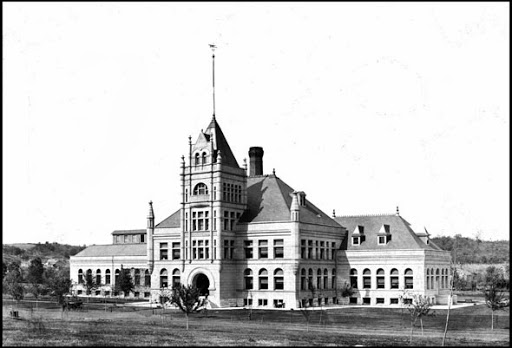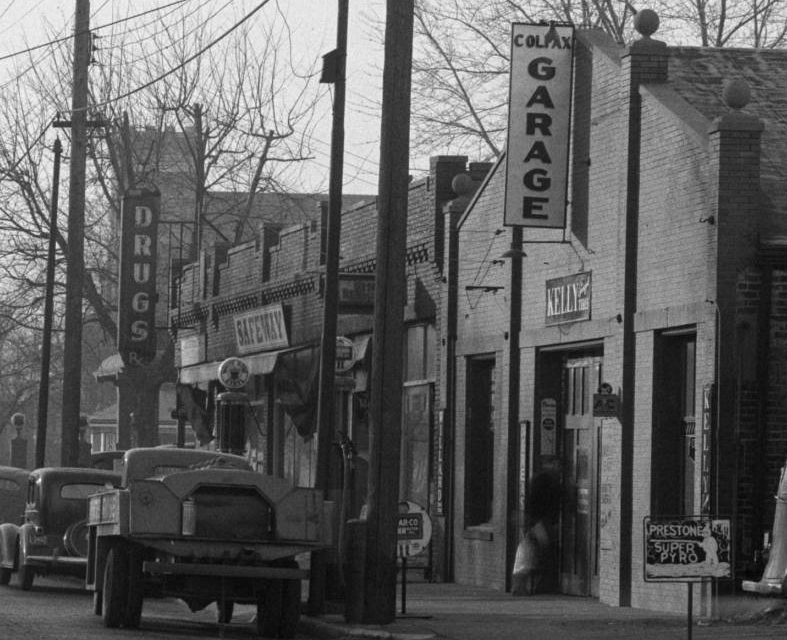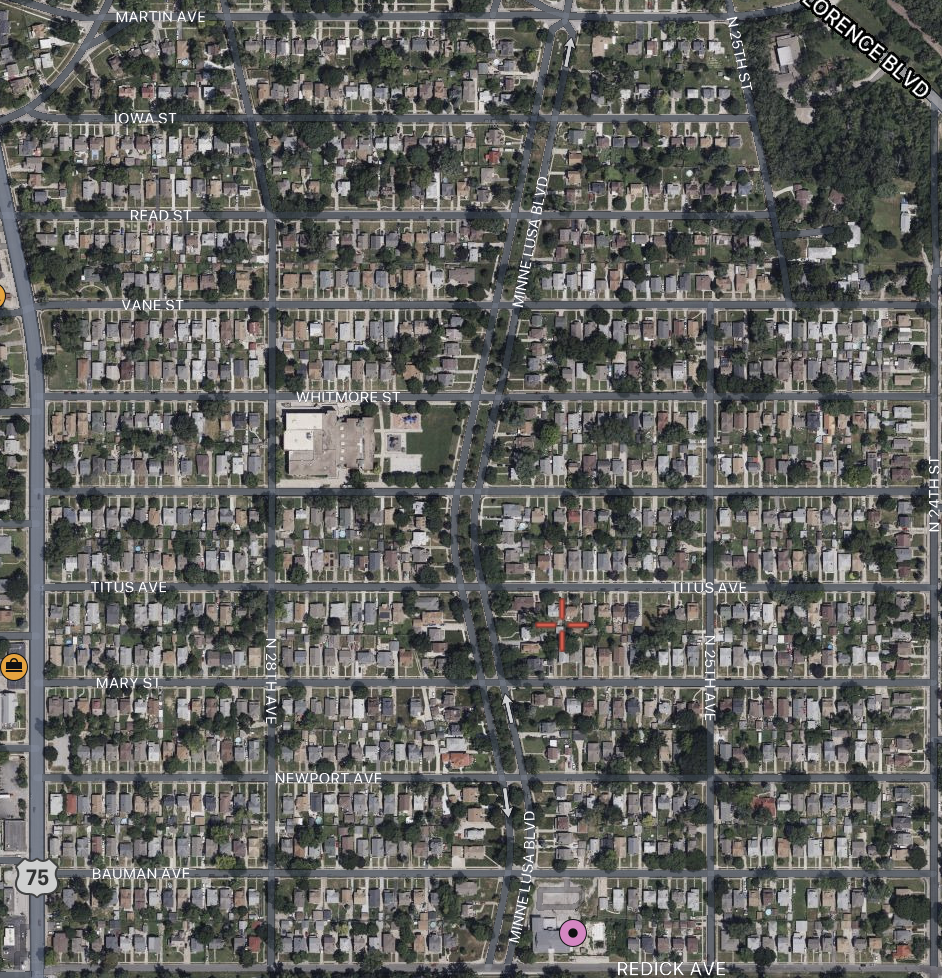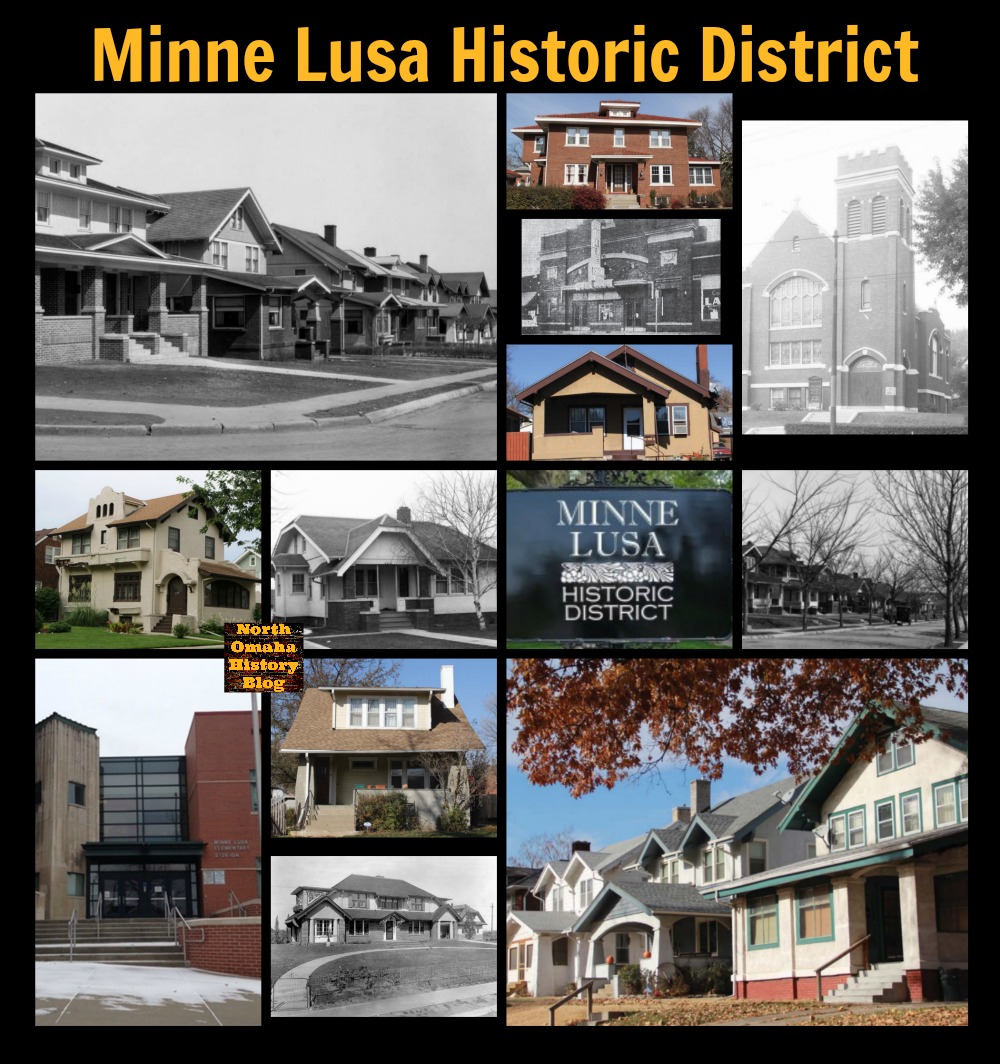“Proud, powerful and transforming.” Asked to think of words to describe the Minne Lusa neighborhood, these came to my mind immediately. I was sitting with a friend in Omaha recently, talking about the changes in North O, and they asked me what I thought of it. I easily remembered summers riding bikes up and down Minne Lusa Boulevard, going to the Viking Ship regularly, eating ice cream and buying cassette tapes at Four Aces Pawn Shop. Even as a kid, I thought the neighborhood was special, with its giant houses on the boulevard and polite houses up and down the blocks, all with an overall feeling of respectful sub-urbanity.

The following is a short history of the neighborhood that I write out of admiration for Minne Lusa’s beauty, my memories, and the people who fill the homes today.
Growing Out Of A Cornfield

“When we bought the land that is now Minne Lusa it was a big cornfield of 128 acres. Endowed by nature with beautiful rolling contour, it needed but the magic wand of man to turn it in a few days into a district of contented home owners.”
—Charles Martin, developer of the Minne Lusa neighborhood
The roots of the Minne Lusa neighborhood go all the way back to 1893, when nationally renowned landscape architect H.W.W. Cleveland designed a citywide boulevard and park system for the City of Omaha. The cherry on his vision was called “Omaha’s Most Beautiful Mile,” which was a tree-lined boulevard packed with fancy homes; a smooth, winding roadway; and gorgeous flowerbeds along its mile-plus length. Its subdivision, called Norwood, was packed with riverview lots for large and medium sized houses. Today, this is part of the section of Florence Boulevard between Storz Expressway and Read Street.
Fancy Name, Better Land

In 1880, the Florence Water Works were completed immediately west of the town of Florence. Nine years later, the American Water Company built the Minne Lusa Pumping Station at the Water Works, and sold the City of Omaha private water that was purified there. The station’s owners said the words they made up, “minne lusa,” supposedly meant clear water in the Sioux language. In reality, the name was a hyperforeignism. A hyperforeignism is a type of qualitative hypercorrection that makes speakers mis-say loanword, and then use it for purposes it was never intended. In this case, the name of the neighborhood was probably taken from the neighboring pumping station or from the creek running through the neighborhood. The creek, which was known colloquially as Manuel Lisa Creek, was named after the Spaniard fur trapper who had a small fort to the north a century before the neighborhood was built. There were other businesses in the neighborhood with the name, too, including the Minne Lusa Lumber Company, which opened circa 1900.
Miller Park was created on the northern edge of the city limits in 1891. More than 30 years after the Florence Water Works were established; 25 years after the Miller Park was created; and more than 20 years after Florence Boulevard was finished, a successful farmer sold his land to a real estate developer. The farmer, named James M. Parker, was a founding father of the town of Florence, Nebraska. An early manager of the Bank of Florence, he eventually bought the land that became Minne Lusa.
Parker’s son, Frederick Parker, kept a studio west of present-day North 30th and Redick Streets. After Frederick and the other heirs got a hold of the Parker Estate, for a long time they kept sowing his acres with tight rows of corn. In 1891, they sold a large chunk of the estate to Dr. George L. Miller. Part of that became the Miller Park and the Miller Park neighborhood. Later another chunk was sold to a man who helped develop the Norwood subdivision mentioned earlier, as well as the Belle Isle subdivision in the Miller Park neighborhood. His name was Charles Martin.
In 1907, the Royal Amusement Company developed plans for 40-acres of today’s Minne Lusa neighborhood. Royal paid $65,000 to an architect named J. B. Mason to design six buildings, including a pavilion, a 2-story dance hall, two dining halls, a boat house, club house and a roller rink. The amusement park never came to exist though, and I can’t find any evidence any work was ever done on it.
The Biggest Subdivision in Omaha

When it was built, Minne Lusa was the biggest subdivision in Omaha to date.
Located in the northern end of present-day North Omaha, present-day Minne Lusa is bounded by North 24th Street to North 30th Street; Craig Street to Redick Avenue. When he built it, Martin bragged about the subdivision having “six miles of water mains, 47 fire hydrants, 12 miles of sidewalks, an ornamental lighting system, 1700 shade trees, and last but not least, a clubhouse.”
As World War I was starting, a local developer named Charles Martin made plans to develop that cornfield. It was one of the last great uncompleted spaces between the Miller Park neighborhood and Florence, and between 1915 and 1926, Martin finished his vision. Different from all of his peers, Martin did not plan a small town like Benson, Dundee or Florence. Instead, he built the largest subdivision in Omaha’s history to that point. Centered on the lulling Minne Lusa Boulevard, the Minne Lusa neighborhood supported a dozen east / west streets, too, along with three north / south roadways.
However, Martin didn’t want to focus everything on a business district, but instead, just homes. Adding just a few amenities to the neighborhood, Minne Lusa became a unique contribution to the City of Omaha’s growth. Some of those amenities included the park-like Minne Lusa Boulevard and the exclusive Prettiest Mile Club. Businesses and churches accumulated around Minne Lusa.
Martin choose the area carefully. When he started, streetcars roamed from Dodge Street to Florence along North 30th Street, and from downtown Omaha almost to Read Street along North 24th Street. A streetcar began running from Fort Omaha to Florence in 1894, and Martin knew to cash in on that.
He was designing for Omaha’s growing middle class population. When he began in 1916, a lot of people started buying his homes: accountants, bookkeepers, buyers, clerks, comptrollers, contractors, dentists, department Managers, engineers, foremen, lawyers, managers, mechanics, small business owners, physicians, postal clerks, salesmen, secretaries, stenographers, teachers, travel agents and company vice presidents. They generally didn’t own cars, rode the streetcars, and shopped very locally.
However, within a decade, although the same types of people were still buying the homes, they were driving their own cars and needed garages. Almost every home in the neighborhood ended up with a garage.
Following are some of the features of today’s Minne Lusa neighborhood.
Homes

The homes in Minne Lusa were supposed to be affordable and varied. Charles Martin wanted his neighborhood to focus on the latest and most popular architectural style though, which was the Craftsman style that was inspired by the Arts and Crafts movement. This approach to designing homes had several features, including:
- Well-designed homes
- Wide front porches
- Low-pitched, gabled roofs
- Pointed window arches
- Tapered columns
- Partially paned doors
- Multi-paned windows
- Earthtone paint jobs
- Single dormers
- Exposed rafter tails and beams under deep roof eaves
- Knee braces
- Brick fireplaces and wooden fittings
- Stone and tiles
- Asymmetrical composition
Seeking am architect who could manifest his vision, Martin hired young Omaha architect Everett S. Dodds. Dodds’ designs for Minne Lusa were particularly important because of their simplicity and adaptability. Dodd created a Craftsman-style home design catalogue that could be used for the entire development with several home styles repeating through a number of variations that made each one look unique. Unlike other subdivisions built in the same time period, Martin didn’t require brick exteriors. Instead, he wanted a variety of surfaces covering his neighborhood, including stucco and wood. Keeping with the Craftsman tradition, a lot of wood was used to build Minne Lusa. Other housing styles throughout the Minne Lusa neighborhood include the Colonial Revival, Neo-Classical, Tudor Revival, and Ranch styles, with two Prairie style homes, too. One of the finest and earliest homes in Minne Lusa was designed by Charles Martin himself, and is located at the intersection of Mary and Minne Lusa Boulevard.

800 lots were sold on 30 blocks throughout Minne Lusa. Martin was so successful with this subdivision that he took on the development of 211 acres north and west of North 30th Street that formerly belonged to the Army at Fort Omaha. It was called Florence Field. The Florence Field subdivision designed by Martin had 1,100 lots and was intended for a more exclusive homeowner.
Places in the Neighborhood



When the Minne Lusa neighborhood was established, there were many parts and places within and around it. These include the homes featured above; following is information on churches, a club, and other places. Here are details about several of them.
Minne Lusa Boulevard

The City of Omaha’s beautiful boulevard system, designed in 1892, was designed to supplement the city’s parks by acting as a ribbon that ties them all together. Upon seeing the city complete the Belvedere Boulevard at the southwest corner of Miller Park, Charles Martin had a vision for his new neighborhood.
He saw two meandering avenues lining either side of the Minne Lusa Creek that weaved its way in a gentle valley between the hills Martin bought for his neighborhood. He laid concrete curbs and streets immediately, channeling the creek through a sewer and covering it with trees on a grass-covered median, and planting soft glowing streetlights the entire length of the strip. The lots lining the Minne Lusa Boulevard were designated for larger houses and cost more to buy.
Martin originally wanted to join his boulevard with North 28th Street in Florence, which was supposed to be made into a boulevard, too. However, when that didn’t happen, Charles Martin designed Martin Avenue to connect to the Fontenelle Boulevard in the far western end of his Florence Field subdivision. This completed a wonderful loop that tied together his neighborhoods into the lifeblood of citywide traffic via the boulevard system.
Businesses
As Minne Lusa grew, the commercial needs of the neighborhood made themselves known. The Miller Park Grocery and a service station developed on the southeast corner of North 24th and Redick Avenue. The Minne Lusa Tavern opened at 7202 North 30th in the 1950s. By 1962, it was the Minne Lusa Restaurant, and by 1978 it was closed. Other businesses surrounded the neighborhood too.
The store 6604 North 30th Street opened as a Piggly Wiggly Grocery Store on April 24th, 1924. By 1938, the store was called a Safeway. By 1945 it was a Save More Super Market, and by 1950 it was Minne Lusa Hardware. They closed in 1976. Four Aces Pawn Shop was opened in the location at some point afterwards.
YMCA
The North Omaha YMCA opened at 6330 North 30th Street in 1946. The original building was a repurposed storefront. In 1958, it was demolished and replaced with another building, which in turn was demolished in 2011 after the YMCA moved out in the 1990s and opened a different facility on Ames Avenue.
Churches
Several churches were built along North 30th Street near Minne Lusa. They included Miller Park Presbyterian, Trinity Lutheran, Blessed Sacrament Catholic, and Parkside Baptist. Mount Olive Lutheran eventually built on the northern edge of Minne Lusa.
Other Places…
- Minne Lusa Creek
- Minne Lusa Pumping Station
- Minne Lusa Theatre
- Minne Lusa School
- Viking Ship / Birchwood Club / Prettiest Mile Club
- Miller Park
- Florence Boulevard
- Florence neighborhood
- Florence Field neighborhood
- Miller Park neighborhood
- Architect Everett Dodds
Challenges and Opportunities

Since its heydays, the Minne Lusa neighborhood has weathered many assaults from many angles.
In the 1970s, the City of Omaha seriously considered running the North Freeway straight through the neighborhood in order to have a connector directly from downtown Omaha to I-680. However, concerned neighbors and community organizations successfully fended off this attack, and the highway ended south of the Miller Park neighborhood.
The Birchwood Club transferred ownership in the 1930s, and endured a poorly executed remodel that stripped it of its historical beauty in the 1960s. The warm, earthy stucco on the outside of the building was replaced with a tacky industrial-type siding and cheap-looking brick, while almost every element in the interior was demolished and rebuilt.
It was sold again in the early 1980s and renamed the Viking Ship. The ballroom was repurposed as a gymnastics facility and the bowling alley was ripped out and replaced with a workout gym and boxing facility. My brother and I boxed there with Kenny when we were young.
The insidious phenomenon of white flight has reared its head throughout North Omaha’s history. Apparently, many middle class white people do not want to live by African Americans. Once thought to be a problem of the last century, student bodies in local schools and homeownership trends show that it is still a relevant factor in home buying in Omaha. Coupled with a generation of aging homeowners looking to move away or simply dying, white flight took a swipe at Minne Lusa.
In the 1990s, home ownership within the neighborhood took a hit as landlords began buying up the beautiful houses in the area that were undervalued by banks, the City of Omaha and Douglas County. The outcome of this behavior led to the degradation of the neighborhood as absentee landlords and under-capable renters lowered the morale of the neighborhood. Despite the value of being well-connected to the rest of the city through the surrounding highways, homebuyers saw Minne Lusa as undesirable and refused to buy homes there. At the same time, the ratio of African Americans to white people living in Minne Lusa raised higher, too.
Fortunately, determination and community building are showing us that mixed race, mixed income neighborhoods in Omaha can survive and thrive. Today, the Minne Lusa neighborhood is a prime demonstration of that reality.
Today

In the early part of the 2010s, a movement within the neighborhood led to a resurgence in community building and positive growth. Between the emergence of new leadership in the Minne Lusa / Miller Park Neighborhood Association and the establishment of the Minne Lusa House, a lot of momentum has been borne of this neighborhood.
Soon afterwards, a group of community members worked together and rallied local resources in support of placing the neighborhood on the National Register of Historic Places. They were successful, and in 2014 they successfully secured a federal designation as the Minne Lusa Residential Historic District.

Additionally, the Minne Lusa Boulevard is included separately on the National Register of Historic Places in a listing for the Omaha Parks and Boulevard System. One of the homes in Minne Lusa, the Harry B. Neef House, is also listed separately on the National Register, too, because of its unique construction in the city.
The neighborhood continues its rebound today. According to their blog, home values are rebounding right now and property ownership is reflecting a larger vision. Neighbors are taking care of their neighborhood again, and Minne Lusa is growing. Here’s to a bright, bold future for my friends in North Omaha’s Minne Lusa neighborhood!

Historical Tour
- Minne Lusa, N. 24th St. to 30th Street; Craig St. to Redick Avenue
- North 24th Street
- Minne Lusa Pumping Station at the Florence Water Works, Grebe St. and John J. Pershing Drive
- Former Miller Park Grocery, North 24th and Redick Avenue
- Trinity Lutheran Church, North 30th and Redick Avenue
- Viking Ship (aka Prettiest Mile Club and Birchwood Club), 2582 Redick Avenue
- Minne Lusa Boulevard, Redick Avenue to J.J. Pershing Drive
You Might Like…
- A History of the Viking Ship, Birchwood Club, and Prettiest Mile Club
- A History of the Florence Field Neighborhood
- A History of the Florence Water Works and Minne Lusa Station
- A History of the Miller Park
- A History of the Belvedere Point Neighborhood
- A History of the Miller Park Neighborhood
- A History of Florence Boulevard
- A Biography of James M. Parker

MY ARTICLES ABOUT HISTORIC NEIGHBORHOODS IN NORTH OMAHA
National Register of Historic Places Historic Districts in North Omaha: 24th and Lake Historic District | Benson Downtown Historic District | Country Club Historic District | Dundee/Happy Hollow Historic District | Fairacres Historic District | Fort Omaha Historic District | Minne Lusa Historic District | Nicholas Street Historic District
Historic Neighborhoods in North Omaha: Bedford Place | Belvedere Point | Bemis Park | Benson | Briggs | Bungalow City | Carter Lake, Iowa | Central Park | Clifton Hill | Collier Place | Creighton University | Crown Point | DeBolt | Druid Hill | East Omaha | Fairfax | Florence | Florence Field | Fort Omaha | Fontenelle View | Gifford Park | Gold Coast (Cathedral) | High Point | Jefferson Square | Kellom Heights | Kountze Place | Lakewood Gardens | Little Russia | Long School | Malcolm X Memorial | Miller Park | Miller Park Duplex Historic District | Monmouth Park | Montclair | Near North Side | North Downtown Omaha | Omaha View | Orchard Hill | Plum Nelly | Prettiest Mile in Omaha | Prospect Place | Raven Oaks | Redman | Saratoga | Sherman | Squatter’s Row | Sulphur Springs | Ponca Hills | Wakonda | Walnut Hill | Winspear Triangle | Wyman Heights
Lost Towns in North Omaha: Benson | Briggs | DeBolt | East Omaha | Florence | Saratoga | Sulphur Springs
Elsewhere Online
- Minne Lusa Blog
- “Minne Lusa Historic District” on Wikipedia
- “Build a Dodds Home” official house catalogue for Minne Lusa
- Minne Lusa House on Facebook
BONUS PICS!






















Leave a comment